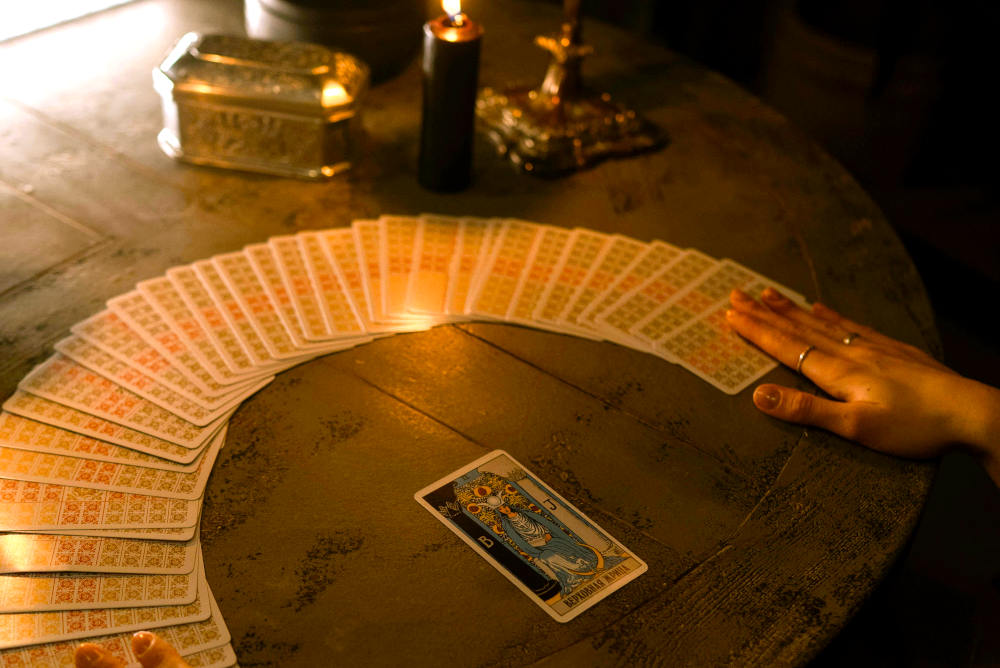
In a world filled with uncertainty, sometimes all you need is a quick yes or no. Whether you’re unsure about a relationship, a job offer, or a decision you need to make, cartomancy—the ancient art of fortune-telling with playing cards—can help provide clarity. Best of all, you can do a free yes or no cartomancy reading from the comfort of your own home using just a regular deck of 52 playing cards.
This article will guide you through everything you need to know about yes or no cartomancy—from how it works and how to prepare, to interpreting the cards and using different techniques to get reliable answers. No special tools or mystical powers required—just intuition, a little practice, and a standard deck of cards.
Panaprium is independent and reader supported. If you buy something through our link, we may earn a commission. If you can, please support us on a monthly basis. It takes less than a minute to set up, and you will be making a big impact every single month. Thank you!
What Is Cartomancy?
Cartomancy is the practice of using playing cards for divination. Long before tarot cards became widely used, people in Europe and beyond were already telling fortunes with playing cards. Cartomancy can answer deep spiritual questions or provide quick, practical guidance.
In a yes or no format, cartomancy is focused and simple: You ask a question, draw one or more cards, and interpret the answer as “yes,” “no,” or “maybe,” based on the symbolism, suit, and color of the cards.
Why Use Cartomancy for Yes or No Questions?
Cartomancy is especially well-suited to yes or no questions for several reasons:
-
Speed: Get a fast, straightforward answer without a full spread.
-
Simplicity: No need for elaborate rituals—just a focused question and a deck of cards.
-
Accessibility: Anyone with a playing card deck can use cartomancy for free.
-
Clarity: Provides direct insight into immediate decisions or situations.
It’s ideal for situations where you want guidance but don’t need a long reading—just a clear yes or no to help you move forward.
The Basics of Playing Cards and Symbolism
A standard deck of playing cards has 52 cards, divided into four suits:
| Suit | Element | Represents | Color |
|---|---|---|---|
| Hearts | Water | Love, emotions, relationships | Red |
| Diamonds | Earth | Money, work, practicality | Red |
| Clubs | Fire | Action, energy, ambition | Black |
| Spades | Air | Thoughts, conflict, change | Black |
Red cards (Hearts & Diamonds) tend to mean yes or favorable outcomes.
Black cards (Clubs & Spades) tend to mean no or challenges.
Some readers also factor in card numbers and face cards, which can add subtlety to your answers.
Method 1: One-Card Yes or No Reading
This is the simplest and fastest method. Here’s how it works:
Steps:
-
Clear your mind and focus on a yes-or-no question (e.g., “Will I get the job?”).
-
Shuffle the deck while holding your question in mind.
-
Draw one card from the deck.
-
Interpret it as follows:
General Interpretation:
-
Red card (Hearts or Diamonds): Yes
-
Black card (Clubs or Spades): No
Optional Nuances:
-
Hearts: Yes, with emotional satisfaction.
-
Diamonds: Yes, in practical or financial terms.
-
Clubs: No, because of delays or effort required.
-
Spades: Strong no, obstacles are in the way.
This method is ideal for quick insight or when you're just starting.
Method 2: Three-Card Yes or No Reading
A more detailed version of the yes or no reading involves drawing three cards to weigh the overall energy of your question.
Steps:
-
Focus on your question and shuffle the cards.
-
Draw three cards.
-
Count how many are red and how many are black.
Interpretation:
-
2 or 3 red cards = Yes
-
2 or 3 black cards = No
-
1 red, 1 black, 1 face card = Maybe / Uncertain / Needs more time
You can also consider the suits for added meaning:
-
More Hearts = Yes in love or emotions
-
More Diamonds = Yes for work or finances
-
More Clubs = No because more effort is needed
-
More Spades = No due to mental stress or conflict
This method is helpful for getting a more balanced perspective, especially when the answer isn’t crystal clear.
Method 3: Five-Card Weighted Reading
If you want more depth, try this five-card spread with a point system:
Points:
-
Red card = +1
-
Black card = -1
-
Hearts/Diamonds face card = +2
-
Clubs/Spades face card = -2
Steps:
-
Shuffle and ask your question clearly.
-
Draw five cards and assign points.
-
Add up the total:
-
Positive score (3 or more) = Yes
-
Negative score (-3 or less) = No
-
0 or ±1 = Uncertain / Ask again later
This is great for complex situations that involve emotional, financial, or mental variables.
Sample Questions to Ask
Here are examples of yes or no questions you can ask:
-
“Will they contact me soon?”
-
“Should I take this job offer?”
-
“Is this the right time to move?”
-
“Will I find love this year?”
-
“Is this person being honest with me?”
-
“Should I make that investment?”
Try to phrase your question clearly and in a way that invites a yes or no answer.
Tips for Accurate Yes or No Cartomancy
-
Stay Focused: Ask one clear question at a time.
-
Set the Mood: Find a quiet place and breathe deeply before shuffling.
-
Cleanse Your Deck: Tap it, knock on it, or pass it through incense smoke to reset its energy.
-
Use a Journal: Track your questions, cards, and outcomes to build confidence over time.
-
Trust Your Instincts: If your gut says “yes” even when the cards say “no,” reflect on why.
-
Don't Repeat Too Often: Asking the same question repeatedly can create confusion.
Should You Include Jokers?
Some decks have Jokers—use them only if you decide ahead of time what they mean. Suggestions:
-
Joker = Wild Card: Unpredictable outcome, free will at play
-
Red Joker = Surprise good news
-
Black Joker = Unexpected problem
Or, simply remove them from your deck for clarity.
Pros and Cons of Yes or No Cartomancy
Pros:
-
Free and easy to use
-
Fast answers anytime
-
Great for beginners
-
Strengthens intuition
Cons:
-
Can oversimplify complex issues
-
Unclear answers if overused
-
Lacks deeper symbolism of tarot
Remember, yes or no readings are best used for simple decisions or as a starting point for deeper inquiry.
When Not to Use Yes or No Cartomancy
Avoid yes/no cartomancy when:
-
Your question is too vague or emotionally charged
-
You’re hoping for a specific outcome (confirmation bias)
-
The issue is long-term or requires multiple perspectives
-
You’re in a distressed emotional state
In these cases, a full reading—or simply waiting—may bring better results.
Final Thoughts
Yes or no cartomancy is a fun, fast, and empowering way to get answers to life’s everyday questions using a simple deck of playing cards. While it’s not a replacement for deeper decision-making, it can offer helpful nudges, warnings, or validations from your intuition and the symbolic language of cards.
By learning how to interpret card suits, colors, and numbers, and by practicing regularly, you’ll sharpen your spiritual insight and develop a personal system of yes/no divination that truly works for you.
So next time you’re unsure what path to take, pull out a deck, ask your question, and let the wisdom of cartomancy guide your next step.
Was this article helpful to you? Please tell us what you liked or didn't like in the comments below.
About the Author: Alex Assoune
What We're Up Against
Multinational corporations overproducing cheap products in the poorest countries.
Huge factories with sweatshop-like conditions underpaying workers.
Media conglomerates promoting unethical, unsustainable products.
Bad actors encouraging overconsumption through oblivious behavior.
- - - -
Thankfully, we've got our supporters, including you.
Panaprium is funded by readers like you who want to join us in our mission to make the world entirely sustainable.
If you can, please support us on a monthly basis. It takes less than a minute to set up, and you will be making a big impact every single month. Thank you.































0 comments